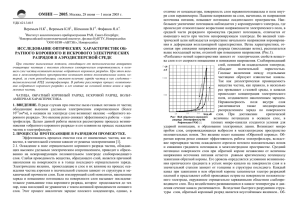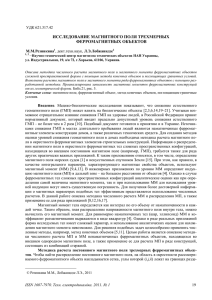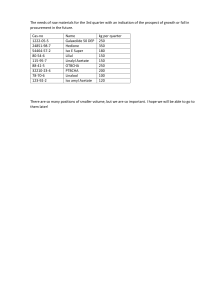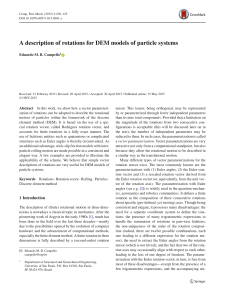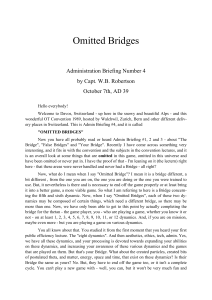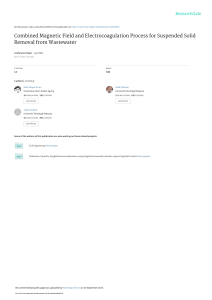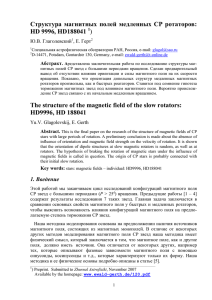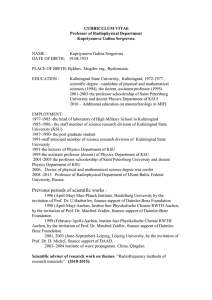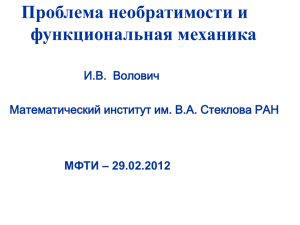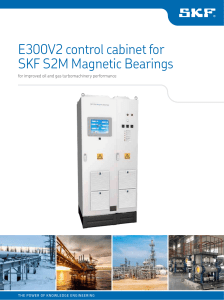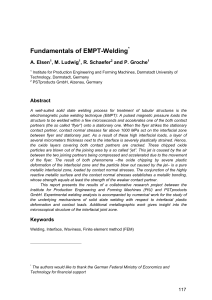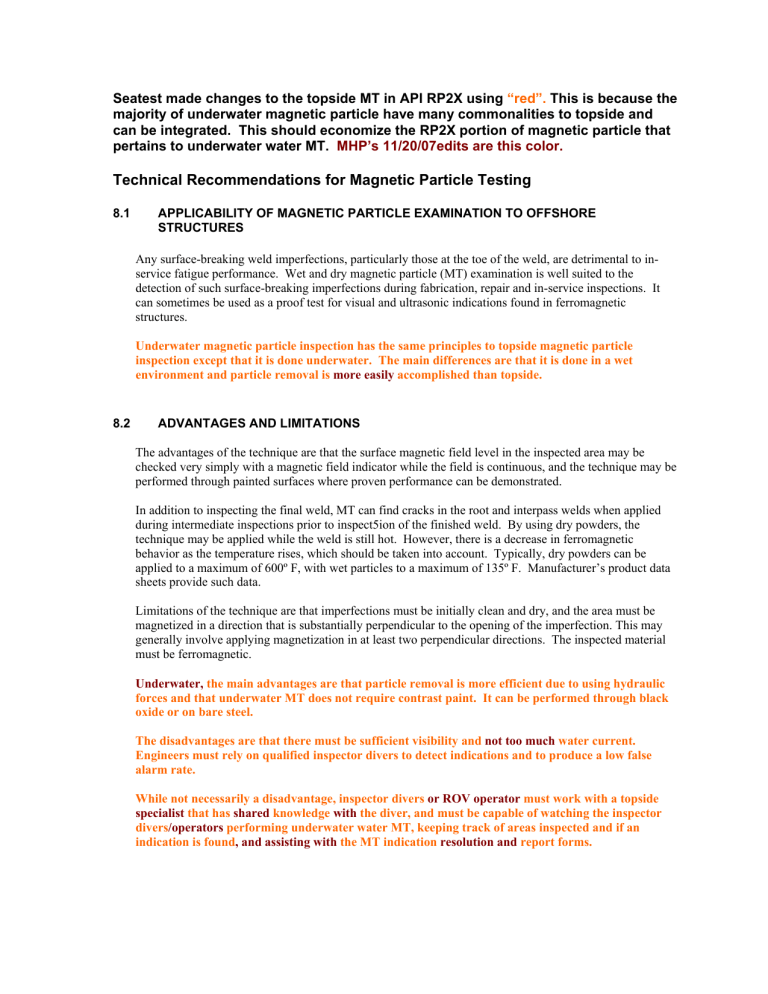
Seatest made changes to the topside MT in API RP2X using “red”. This is because the majority of underwater magnetic particle have many commonalities to topside and can be integrated. This should economize the RP2X portion of magnetic particle that pertains to underwater water MT. MHP’s 11/20/07edits are this color. Technical Recommendations for Magnetic Particle Testing 8.1 APPLICABILITY OF MAGNETIC PARTICLE EXAMINATION TO OFFSHORE STRUCTURES Any surface-breaking weld imperfections, particularly those at the toe of the weld, are detrimental to inservice fatigue performance. Wet and dry magnetic particle (MT) examination is well suited to the detection of such surface-breaking imperfections during fabrication, repair and in-service inspections. It can sometimes be used as a proof test for visual and ultrasonic indications found in ferromagnetic structures. Underwater magnetic particle inspection has the same principles to topside magnetic particle inspection except that it is done underwater. The main differences are that it is done in a wet environment and particle removal is more easily accomplished than topside. 8.2 ADVANTAGES AND LIMITATIONS The advantages of the technique are that the surface magnetic field level in the inspected area may be checked very simply with a magnetic field indicator while the field is continuous, and the technique may be performed through painted surfaces where proven performance can be demonstrated. In addition to inspecting the final weld, MT can find cracks in the root and interpass welds when applied during intermediate inspections prior to inspect5ion of the finished weld. By using dry powders, the technique may be applied while the weld is still hot. However, there is a decrease in ferromagnetic behavior as the temperature rises, which should be taken into account. Typically, dry powders can be applied to a maximum of 600º F, with wet particles to a maximum of 135º F. Manufacturer’s product data sheets provide such data. Limitations of the technique are that imperfections must be initially clean and dry, and the area must be magnetized in a direction that is substantially perpendicular to the opening of the imperfection. This may generally involve applying magnetization in at least two perpendicular directions. The inspected material must be ferromagnetic. Underwater, the main advantages are that particle removal is more efficient due to using hydraulic forces and that underwater MT does not require contrast paint. It can be performed through black oxide or on bare steel. The disadvantages are that there must be sufficient visibility and not too much water current. Engineers must rely on qualified inspector divers to detect indications and to produce a low false alarm rate. While not necessarily a disadvantage, inspector divers or ROV operator must work with a topside specialist that has shared knowledge with the diver, and must be capable of watching the inspector divers/operators performing underwater water MT, keeping track of areas inspected and if an indication is found, and assisting with the MT indication resolution and report forms. While not necessarily a disadvantage, Underwater magnetic particle inspection requires video and photographic images with a quality such that engineers have a high confidence level of the indication as well as its characteristics. 8.3 PROCEDURE QUALIFICATION AND APPROVAL The following applies concerning procedure qualification and approval of magnetic particle testing: a. Written MT examination procedures should be prepared by the NDE specialist, approved by the owner, and continues in force until cause is shown to question their validity. b. The following list of essential variables should be covered in the written procedure: 1. Type of weld to be examined 2. Type of magnetization equipment 3. Surface preparation 4. Examination sequence 5. Timing, for example specified inspection delay after welding, or relative to PWHT if performed 6. Magnetization plan 7. Magnetic field direction for continuous method 8. Magnetic field strength at inspection location during continuous magnetization 9. Magnetic particle type – wet or dry – and color contrast with inspected area 10. Removal of excess particles (underwater flow velocity limits) 11. Interpretation of indications 12. Acceptance criteria 13. Reporting form(s) and procedure c. An evaluation of the system performance and sensitivity should be demonstrated prior to the beginning of any testing work. This may be included within the written procedure. d. Significant variations from the accepted procedure should be taken as cause for re-qualification of the procedure. Due to the criticality of relying of the inspector diver’s performance it is recommended that inspector divers/operators be prequalified. Appendix X provides a means to qualify inspector divers/operators. 8.4 EQUIPMENT 8.4.1 Technique For this practice the continuous method, which employs an alternating current (AC) articulating electromagnetic yoke (double leg, or single leg configuration) with either dry while-light-visible or wet magnetic particles, should be used. The inspected surface should be cleaned where necessary and covered with a light contrast coating (typically white-contrast paint less than 0.002 inches thick). The method requires that the examination take place while the magnetizing current is on, including application of particles, removal of excess particles, and indication interpretation. 8.4.2 8.4.2.1 Yokes Yoke Selection Yokes should be of the AC articulating-leg type to allow for the inspection of various geometries. A single-leg yoke can be used in areas of tight access. Fixed-leg yokes should not be employed. AC yokes should have a lifting power of a t least 10 pounds (4.55 kilograms) when the legs are spaced at the inspection distance. DC yokes have been found to be not reliable in the detection of surface and subsurface defects. Underwater AC yokes should be designed to be turned on and off from the surface. For safety, in all cases, a ground fault interrupters must be used. Lift strength calibrations shall be performed with the full length of the cable to be used. 8.4.2.2 Magnetizing Field Terminology for Yoke Inspection Since lines of flux run generally longitudinally between the poles of a yoke (see Figure 49), the term longitudinal magnetization will be employed in this document to describe this situation. Flux lines flow radially in the part from a single leg yoke (Figure 50); and the term radial magnetization is used in this document to describe this situation. 8.4.2.3 Magnetizing Field Direction During Yoke Inspection Field direction is important because the strongest magnetic flux leakage fields from imperfections are produced when the lines of flux cross the discontinuity perpendicularly. Indications will not generally be produced when the lines of magnetic flux run parallel to the discontinuity. 8.4.2.4 Verification of Performance and Sensitivity Yokes should be routinely tested as described in 8.6 to ensure that the required magnetization performance and sensitivity levels are met during inspection. 8.4.3 Magnetizing Current From 50 hertz to 60 hertz AC electro-magnetization is optimal for detection of surface-breaking discontinuities and will be used as the primary method in this recommended practice. AC causes a “skin effect” which restricts the magnetizing field to the part’s surface, and creates good particle mobility. System sensitivity is checked with a suitably located pie gauge. In wet conditions, a suitable ground fault interrupter shall be used with AC in order to ensure proper safety for the technician against electrical shock. DC magnetization should never be used as the sole means of detection of surface-breaking defects and the use of DC in any inspection scenario is discouraged. Figure 49 – Longitudinal Field Produced by Electromagnetic Yoke Setup Figure 50 – Radial Field Produced by “Single-Leg” Electromagnetic Setup 8.4.4 Magnetic Particle Material and Application The particles should be non-toxic, finely divided high-permeability ferromagnetic material with low retentivity and a suitable size range. Dry particles should have 75 percent (wt) finer than a 120 ASTM sieve mesh, a minimum of 15 percent (wt) dry particles being finer than 325 ASTM sieve size. Their color should be selected to provide high contrast to the background on which they are to be applied. Particles should be free from rust, fillers, or other material that could interfere with their use. Magnetic particle materials should be used only once. Particle application and removal equipment (that is, powder bulbs, aerosol sprays, dispenser bottles) should be such that fine indications are not removed by excessive force. Topside, a powder bulb with many 1/32-inch holes is optimal. Underwater flow velocities for particle removal should be calibrated by practice or equipment selection. 8.4.4.1 Sequence for Dry MPI a. Place yoke on weld and energize yoke. b. Evenly apply powder while yoke is still on (continuous method). c. While the yoke is energized gently blow away excess particles. d. Observe inspection area during this process to witness formation of indications. e. Evaluate indications to specification criteria prior to yoke reorientation. f. Turn yoke 90 degrees and repeat steps a through e. 8.4.4.2 Sequence of Wet MPI a. Place yoke on weld and energize yoke. b. Bathe inspection area with wet particles. c. Maintain continuous magnetization throughout the inspection process. d. While yoke is still energized gently wash away excess. e. Observe inspection area during this process to witness indication formation. f. Evaluate indications to specification criteria prior to yoke reorientation. g. Turn yoke 90 degrees and repeat steps a through f. Sequence of Underwater Particle Usage Underwater magnetic particles shall be daylight or blue light fluorescent. Daylight fluorescent particles shall be mixed in an eight ounce plastic bottle that has an ~1/8 –inch hole in the bottle top. The particles shall have a suitable surfactant such that they flow evenly over the surface to be inspected. The bottle shall have three 3/8 inch stainless steel balls to be used to agitate the particles. The particles should be mixed in slurry. This practice recommends that the particle bottle be filled with ~50% particles and 50% water. The slurry should be stirred such that it is in a colloidal solution. While, there is no warning on most particle products, personnel should mix the particles using a dust mask to prevent airborne dust from being inhaled. Once the solution is made, the bottle should be taped with electrical tape to prevent leakage, or the bottle should have a flip up type of applicator. If electrical tape is used, it should be disposed in a manner that causes no pollution. Bottles are recommended to be put in a mesh bag for safe keeping. One 8 ounce bottle with a 50% mix of particles should cover 10-15 feet of weld. Once on site, the inspector diver should agitate the particles such that the balls can be heard indicating mixture. The particles shall be applied with the continuous method and such that a uniform mixture is spread onto the inspection site. Once the particles settle the excess shall be removed by the divers practiced hand wave such that hydraulic flow is between the yoke legs. Particle removal using a back and forth motion should not be used as it does not properly remove particles and may create false alarms. ROVs should have a calibrated device and usage protocol for producing the particle removal flow. Once the particles are applied and removed the diver/operator shall look for the presence of any indications. If there are no indications, the inspector diver/operator should move the yoke to the next inspection site and repeat the process. If transverse indication detection is required, the yoke should be turned 90 degrees and the process repeated. The removal force of excess particles shall be demonstrated during calibration of the magnetic field indicator. During the application and removal, if there is no indication, the background shall be free of any particles. As particles are applied from the bottle, the magnetic particle solution will be slightly reduced by dispersion. The inspector diver/operator and topside inspection engineer should be aware when particle strength becomes weakened. A check for the adequacy of the particle solution can be checked on a magnetic field indicator or by applying particles to a yoke leg and observing adequate build up. Particles that are not used during a 12 hour shift shall be discarded as the iron filling will begin to rust. Blue Light Fluorescent Particles The use of blue light fluorescent particles may be advantageous especially if short length indications are required for detection or visibility is turbid. Blue light particles require the use of special particles certified by the manufacturer and a matching yellow barrier filter is used for optimal inspection. There is no requirement that blue light particles shall be used in a darkened area. Blue light particles can be used in underwater water environments where ambient light does not exceed 500 foot candles. 8.4.5 Lighting a. Adequate “white light” should be provided for observation of particle indications. Since inadequate lighting can degrade visual acuity, the inspector should check the contrast between the particle indications and the background when working in artificial light. b. A minimum of 100 foot-candles (1000 lux) should be present at the inspection location. This should be measured with a calibrated light meter. c. Since flashlights generally do not provide sufficient illumination, yoke-mountable lamps are recommended where necessary. d. Adequate while light (>100 foot-candles) is also required for the performance of visual inspection at magnetic particle indication sites. e. For verification of lighting level, lighting requirements should be routinely tested (see 8.6) to ensure that minimum lighting conditions are met. Underwater particles which are daylight fluorescent and require 200 foot candles at the inspection site. Underwater lights that have a low profile should be attached to the yoke to ensure proper lighting. When blue light fluorescent particles are used the lighting intensity shall be ____. This intensity measured in microwatts and wave length may be used given the manufacturer’s specifications. 8.5 EXAMINATION TECHNIQUE 8.5.1 Examination Plan and Acceptance Criteria A written examination plan should be developed according to the geometry of the pieces to be inspected, yoke application, light levels, accessibility, safety, and other factors that could affect system performance. Examinations should always be conducted with sufficient overlap to ensure 100 percent coverage. However, if the geometry of the piece does not permit the inspector to perform 100 percent evaluation of the piece, this information must be made available on the report to the owner. Unless otherwise specified, the owner should specify the areas and percentages of the part to be examined by MT. The owner should also specify and acceptance criteria for the test in the examination plan. (Typically, any linear discontinuity is rejectable. However, the owner may also define reportable limits of other weld conditions). Underwater magnetic particle inspection is primarily used as an in service method. The use of the underwater magnetic particle inspection method has been proven by PDI’s to have a probability of detection (POD) of 95% for detecting indications that are ¼ inch length by 1/32 inch depth. The owner may select a different threshold level for reportable indications of real concern to structural integrity management, with a view towards minimizing false alarms. The location and specific area of coverage for the MT inspector should be verified and referenced to the examination plan or drawings, and should be reference on the MT general report. The examination plan should also include the technique. Typically, two options exist for the detection of fabrication discontinuities, as follows: a. MT for both longitudinal and transverse discontinuities (see Figures 53 and 54) b. MT in one discontinuity direction only. Generally discontinuities which grow in service will be parallel to the weld axis and transverse to the local hot spot stress. During fabrication, the MT inspection should check for discontinuities at all angles, with the part being magnetized in at least two perpendicular directions. For in-service inspection, the major classes of indications that occur on fixed offshore structures are longitudinal toe cracks, and in order to maximize inspection efficiency, the owner may specify that MT be performed for only the longitudinal direction However; designers of inspection plans should be familiar with structural welds relative to discontinuities. For example, on MODUs, fabricated from HY80 steel, transverse cracks may be of inspection importance. 8.5.2 Identification and Marking of Welds The owner may specify, or ask the testing agency to submit, a practice for identifying (naming) specific joints inspected. On certain welds it may be desirable to mark inspection starting and finishing points, or areas of relevant indications. The owner should specify whether the weld to be examined should be temporarily or permanently marked. Marking techniques should be approved by the owner. If permanently marked, the marking should be sufficient to retain its identity until after final evaluation and subsequent evaluations. It is recommended that material testing and found to have relevant discontinuities be permanently marked to facilitate relocation and for repair purposes. A low stress “arrow” stamp is recommended for this purpose. Underwater water MT inspection sites can be marked using magnetic labeling or “lumber crayons”. As well low stress stamps can be used underwater. 8.5.3 Surface Preparation 8.5.3.1 Surface Condition Proper surface condition is essential to MT. All welds should be inspected visually for detection of gross imperfections and demarcation of the area to be cleaned before the application of any paint or coating. Cleaning to bare metal prior to MT can be accomplished by grinding weld passes in butt welds, sand blasting, water blasting, wire brushing, needle scalers, hand scraping, or a combination of these. Cleaning removes weld spatter, rust, and any existing paint. Welds to be inspected in the “as-welded” condition should be dry and free from contaminant materials such as dirt, grease, and weld spatter. A light coating of contrast paint should be applied to assist in detection of smaller imperfections. Underwater Cleaning for MT Underwater water cleaning for MT can be accomplished in many ways. The main methods are underwater high pressure waterblasting, sand blasting, needle gunning. High pressure underwater cleaning by water blasting (20 kpsi at 10 gpm) usually results in either black oxide or cleaning to bare metal. MT through thin tight black oxide produces acceptable results, similar to bare metal. This is especially true For underwater painted structures in which paint preservation is desired, case a fan jet should be used. The effect of the paint or other coatings on reducing inspection sensitivity should be determined by trials at the maximum coating thickness. Special safety precautions should be taken when using high pressure water blasting and should be performed only by divers trained in this method. Underwater water sand blasting leaves a matte finish and for small areas or inspection programs is intrinsically safer than high pressure water blasting. Underwater needle gunning is a safe and is reasonably efficient. It is usually used as an air tool and thus is confined to shallow water inspections (~90 ft). Other methods such as hydraulic wire brushing or the use of hand tools are not recommend due to their low rates of efficiency. 8.5.3.2 Painted Material Welds which have been painted for other reasons should have the coating removed unless adequate sensitivity to MT can be demonstrated. Typically, a paint thickness in excess of 0.006 inch may reduce the sensitivity of MT by the AC yoke method to an unacceptable level. It is often necessary to remove the coating only in the area of interest, typically the weld and heat affected zone. Where uncertainty of the coating thickness exists, it should be checked with a calibrated dry film thickness gauge. Calibration should be performed to be accurate within the range to be measured. Underwater structures that are painted most always require the paint to be removed at the weld, weld toes and 1 inch each side the weld. Placement on yoke legs on paint less than 0.040 inch thick is acceptable as long as the weld is cleaned as described under (see X.X) 8.5.4 Yoke Placement and Leg Orientation See figures 49, 50, 53, 54, 55, 56 and 57 for yoke placement and leg orientations. For longitudinal direction inspection, the yoke should be astride and perpendicular to the weld. For transverse direction inspection, the yoke should be oriented so that it is basically parallel to the weld. Figure 51 – Magnetization Plan Setups Figure 52 – Illustration of API-Recommended Magnetic Field Indicator 8.5.4.1 Examination for Longitudinal Discontinuities with a Yoke Figures 51 and 55 show preferred methods of placement for the yoke when inspecting a T-connection (90º local dihedral angle). A similar yoke configuration should be used when inspecting other dihedral angles, as in Y or K connections. The effective inspection are4a is the weld between the yoke legs, and a lateral area of approximately 1.5 inches (38 millimeters) on each side of the centerline of the yoke legs. The total effective area of linear weld coverage for one position of the yoke is approximately 3 inches (76 millimeters). This effective area is dependent upon the leg spacing and part geometry which determines the tangential magnetic field strength at the part surface. This can be quantified by the use of an electronic Hall-effect gauss meter (tesla meter). (See 8.). Sufficient overlap should be used to ensure 100 percent coverage when moving along the weld length. Yoke movement in 2-inch (50 millimeter) intervals should ensure adequate overlap. The yoke legs should be positions such that they are approximately 1 inch to 1/2-inch (25-12 millimeters) from the toe of the weld. This places a strong magnetic field strength at the toe of the weld, the area of highest predicted discontinuity occurrence. For wet MT, sufficient time should be allowed to ensure formation of indications. For dry MT in the flat and horizontal weld position, the yoke may be dragged slowly over the inspection area while particles are continuously applied and gravity assists in removal of excess particles. However, when inspecting variable dihedral angles such as Y or K connections, adjustments to the yoke legs will be necessary to make sure that the legs have good contact with the surrounding base metal. 8.5.4.2 Examination for Longitudinal Discontinuities with a Single-Leg Yoke When inspecting in the longitudinal direction, one may not be able to gain access to all locations, for example the heel and toe zones of a tubular Y-connection. In these locations, a single-leg method may be used. This places a radial field in the part (see Figure 50). This may be accomplished by moving one leg out of the way to gain access. Acceptable results can be obtained when the yoke leg is laid flat against the area being inspected (see Figures 56 and 57). In this configuration, the effective inspection area may be surveyed with a Hall-effect gauss meter (tesla meter). The single leg should be place 1/2 inch (12 millimeters) from the weld. A minimum field of 20 Oe must be present at the inspection site. This can be predetermined by using a gauss meter to define gaussian fields under certain geometries. The total effective inspection area may be as little as one square inch in front of the leg. For this reason, it may be necessary to place the single leg on the base metal on each side of the toe of the weld in order to assure that an adequate magnetization has occurred. Sufficient overlap should be used to assure 100 percent coverage when moving along the weld length; movement in 1/2-inch intervals should assure adequate inspection overlap. 8.5.4.3 Inspection for Transverse Discontinuities with a Yoke Transverse indications are best detected when the weld is scanned with the yoke legs parallel to the weld and approximately 1/2 inch (12 millimeters) from the toes. If the yoke has to be placed on top of the weld to gain access, the technician should ensure the best contact possible of the yoke legs to the weld (see Figure 54). The effective area will be the weld between the yoke legs. A 4-inch (100 millimeters) leg spacing is recommended. Sufficient overlap can be achieved by moving the yoke to a position which overlaps the last position by at least 1 inch (25 millimeters). If the weld is extremely wide (greater than 2 inches (50 millimeters), it may be necessary to inspect by placement of the yoke on both sides of the welds. Figure 55 – Incorrect and Correct Electromagnetic Yoke Setup for T and Y Joint Connections Figure 56 – Acceptable Setup for Scanning with “Single-Leg” Electromagnetic Method Figure 57 – Single-Leg electromagnetic Setup for Detection of Longitudinal Discontinuities 8.5.5 Application of Particles 8.5.5.1 Dry Particles Dry particles should be applied in such a manner that a light, uniform dust-like coating of particles settles on the part while it is being magnetized. The MT personnel should observe for particle indications being formed as the powder is being applied, and while the excess is being removed. Care must be taken in removing excess particles so that fine, or weakly held indications are not removed. However, sufficient air velocity must be directed at the area of inspection to remove the excess particles that are not primarily held by magnetic flux leakage from discontinuities, but rather by mechanical entrapment in areas such as weld undercut and underfill. 8.5.5.2 Wet Particles When using the wet method, excess particles are usually removed by gravitational drainage. Therefore, when working above water on a flat surface, care must be taken to produce a background that pooling does not produce excessive particle background, which can cause false indications. 8.5.5.3 Particle Removal Correct magnetization and particle removal techniques should be determined by use of a magnetic field indicator (pie gauge), or by the use of a test specimen. 8.5.6 Inspection Timing See Section 6.1 8.6 EQUIPMENT PERFORMANCE CHECKS (STANDARDIZATION) AND EVALUATION OF SYSTEM SENSITIVITY The performance and sensitivity of a magnetic particle inspection (that is, the combination of magnetizing and illuminating equipment, magnetic particle material, the sequence of operations, and the like) should be monitored at regular intervals to assure the required performance level (see Table 1 for recertification intervals and Table 2 for performance check intervals). The tests to be discussed in this section should be performed at the following times: a. Prior to each examination b. At the end of each examination c. Any time that the MT personnel and/or owner feel that conditions have changed which might affect the sensitivity of the MT technique. The following MT performance/sensitivity parameters should be checked prior to performing any examination and should be documented by a written procedure. This is sometimes referred to as standardization: a. Yoke magnetizing strength b. Yoke set-up c. Field direction d. Magnetic particle performance e. Excess particle removal force f. Lighting at inspection surface 8.6.1 Yoke Magnetizing Strength To check yoke magnetizing strength, proceed as follows: a. Check that the AC yoke will lift a 10-pound (4.55 kilograms) calibrated steel bar with the legs at the inspection spacing. An AC yoke used in the single leg configuration shall be able to lift 9 lb. b. Note that 2-leg or 1-leg yokes should produce clearly defined indications on a magnetic field indicator (pie gauge – see Figure 52 in the area of inspection). The indication must remain after excess particles have been removed. A two-leg should produce a field of 30 Oersted (24 Amperes/centimeter) in air in the area of inspection (see Figures 53 and 54). The field strength that is tangential to the inspected surface may be measured with a suitable calibrated Hall-effect gauss (tesla) meter. A one leg yoke shall be able to pick up a 9 pound weight and should be able to produce a 20 Oe level one inch in front of the single leg. Field distribution plots of iso-magnetic lines can be made for various yoke and part configurations in order to verify the inspection area envelope. 8.6.2 Yoke Set Up A magnetic field indicator should be used to verify each yoke set-up. Clearly defined magnetic particle indications must appear o the indicator prior to inspection. 8.6.3 Magnetizing Field Direction A magnetic field indicator should be used to check the correct orientation of the yoke relative to the field it produces and the direction of discontinuities that it can detect. The discontinuities on the field indicator should be placed in the same direction as the discontinuities in the weld required to be detected. 8.6.4 Magnetic Particle Performance Dry magnetic particles should be checked for compliance to the ASTM mesh condition (see Section 8.4.4) prior to starting an examination. Wet magnetic particle solution should be checked for compliance to manufacturer’s optimal concentration level using a magnetic field indicator. Clear indications should be observed with each type of particle on the field indicator placed on a steel test surface midway between the legs of a yoke. Underwater magnetic particles should be checked to insure there are adequate particles in the bottle’s solution by verifying prior to beginning an inspection using a magnetic field indicator. During the inspection, the inspector diver can check for adequate particle strength by checking particle strength on a magnetic field indicator or by applying particles to the yoke’s leg and verifying adequate concentration. Furthermore, the topside inspector witnessing the test may prompt the inspector diver if they observe a weak solution via the video. 8.6.5 Excess Particle Removal Force A field indicator should be used to adjust the force required to remove excess particles without removing indications. However, specimens containing field-removed discontinuities or fabricated discontinuities provide optimum means to practice particle removal skills. Underwater water magnetic particle removal force (method, proximity and velocity) should be an essential variable that is tested for during performance demonstrations. 8.6.6 Lighting Levels White light intensity should be verified at the inspection surface using a suitable light meter. Underwater water light intensity can be checked for a certain light and distance from the inspection area using a suitable light meter and then certified for this specific light. In some cases, a diver helmet mounted light may be used to assist the yoke light. However, it can not be solely relied upon as it may not be able to uniformly illuminate all areas in the inspector diver’s field of vision. 8.6.7 Use of Field Removed Discontinuity Specimens Representative field-removed specimens with known discontinuities can provide a reliable means to quantify and evaluate the performance and sensitivity of a magnetic particle testing practice. The specimens and flaws should be of the types and severity normally encountered during fabrication or service. Such test specimens should be considered when evaluating a testing agency’s performance and qualifying inspection personnel. 8.6.8 Use of Specimens with Manufactured Discontinuities Specimens containing relevant and nonrelevant indications in the base metal, toe of the weld, and weld face can be used for evaluating the performance of MT methods and qualifying personnel. Specimens with documented manufactured indications are readily available. 8.6.9 Use of EM Notches An EDM notch, as small as 1/16-inch length by 0.020-inch depth by 0.002-inch open width, can be used to test the performance sensitivity of the MT methods. A depth to width ratio of 10:1 is usually used as a number to produce a relevant indication. This depth to width ratio should be maintained for larger notches up to the target 95% POD size. 8.9 INTERPRETAION AND EVALUATION OF INDICATIONS Relevant MT indications result when magnetic flux leakage (MFL) fields formed by discontinuities attracts and holds magnetic particles. Other MT indications caused by particles held by nonmagnetic forces or weak leakage field from weld geometry or permeability changes are termed “false” indications. MT indications incorrectly evaluated as “relevant” indications are termed “false positive” indications. 8.7.1 False and Nonrelevant Indications False indications are those that are held primarily by non-magnetic means, for example, mechanical entrapment in the toe and interbead of a weld. Typically, however, they will not produce sufficient MFL to produce a relevant indication. This occurs because of the following: a. The discontinuity geometry produces a low depth-to-width ratio. b. The flux lines flow beneath the discontinuity and those which do emerge generally have insufficient curvature to hold particles. If excess particles are not properly removed, the possibility arises for false interpretation. The term “non-relevant” indication is often used in conventional MT to mean a particle indication which is held in place by magnetic attraction, but does not originate from a structural discontinuity. An example of this is the MT indication formed at the boundary of two steels having significantly different magnetic permeabilities. Magnetic nonrelevant indications can be created by the hardened heat-affected zone of a weld, but can usually be identified by their diffuse nature. 8.7.2 Evaluation of Indications Testing personnel should properly evaluate indications by the following: a. Re-evaluation of the indication by retesting with the yoke field perpendicular to the discontinuity indication if it is not already perpendicular. b. Re-testing and ensuring that excess particles are removed. If the suspect indication is removed during the retest, the indication is interpreted as not relevant, or as a false indication. Typically relevant indications retain particles after all excess particles have been removed. c. If the indication has a light particle buildup and weak particle adhesion, and if doubt exists as to whether the indication is relevant or false, the area of the indication should be lightly surface-ground (see 8.7.4 below) and retested. Conversely, care must be taken to ensure that relevant indications are not masked by nonrelevant ones. Overlap and undercut may cause relevant surface indications. Both can cause problems by masking weld toe cracks. They can be visually identified, producing a light MT indication, and be interpreted and evaluated by light surface grinding. For underwater in-service inspections, it is particularly useful to distinguish between fatigue cracks and weld toe undercut caused by HAZ corrosion. The latter typically have a lower depth-to-width ratio as described above for non-relevant indications. The topside inspector shall be responsible for recording all data required to make an evaluation by parties other than the inspector diver and the topside MT inspector. For this reason, it is critical that all indications be recorded by using high quality digital still cameras. 8.7.3 Estimate of Indication Depth As commonly practiced, MT does not provide quantitative information regarding imperfection depth. For the purpose of this practice, an attempt should be made to provide particle buildup information as a function of discontinuity depth. A heavy buildup with strong adhesion of the particles almost always indicates a discontinuity depth greater than 1/32-inch to 1/16-inch (0.7 millimeter – 1.5 millimeter). A fine buildup with light adhesion will typically indicate a shallower discontinuity, or one which is in heavy compression. Light surface grinding of indications that have a fine buildup may provide relative information on the width of the discontinuity. Any additional information pertinent to the indication should be detailed under the remarks section of the Magnetic Particle Indication Form (Appendix D). All final evaluations should be performed by qualified Level II MT personnel who are also responsible for ensuring that all required information is documented on the appropriate report form(s). 8.7.4 Grinding With proper grinding techniques, shallow surface cracks or incomplete fusion can be ground out, making an effective repair. The following guidelines apply: a. Owner approval: grinding is a means to further interpret and evaluate MT indications. Extreme caution should be taken to implement and use proper grinding techniques, since improper grinding can create stress risers where a sound weld may have existed. Grinding should be approved by the fabricator and the owner. b. Dimensional requirements: A maximum of 1/16-inch (1.5 millimeters) metal removal is permitted unless otherwise specified or permitted by the owner. For shallow grinding, depth should be maximum at the indication axis, the depth-to-width ratio of the excavation below either adjacent base metal surface should not exceed 1:4. This will ensure that the proper weld size and profile remain and that stress risers are not induced at the grinding site. The grinding should be contoured, radiussed, and blended into the area of the weld and/or surrounding base metal. Grinding should be tapered for 1-inch (25 millimeters) past each end of the indication, or four times the depth where deeper grinding is permitted, to optimize metal contouring. Where specially qualified and approved as an in-situ remediation procedure, deep grinding need not have an excavation width greater then 1/2-inch (12mm), as long as a smooth 1/4-in (6mm) radius is maintained at the bottom. c. Types of grinders: pencil-type grinders with radiussed burrs are recommended. The optimal grinding burr is recommended to be a ½ inch diameter bull nose tungsten carbide, double cut burr. Grinding-wheel tools are acceptable for topside work only, with small diameter shaped-edge and thickness wheels preferred. d. Measurement of grind: the depth of the grind should be continuously checked during the grinding process with a calibrated mechanical measuring device. See Figure X. e. Retest: all indications that are ground should be continuously reinspected with MT with the yoke in the same position as previously used to detect the discontinuity. It may, however, be necessary to use magnetic particles of a different color in order to have good contrast with the newly ground metal. For underwater inspection, grinding should be performed by a diver who has satisfactorily demonstrated his workmanship skills on node and weld geometries similar to the in situ work. Grinding by an ROV is not recommended, nor is it prohibited. Special attention must be paid to such issues as depth perception, force feedback, and precision of movement. An underwater workmanship demonstration is required for each vehicle-manipulator-tool-operator combination. Daylight fluorescent underwater water particles have good sensitivity to insure indication removal. In some cases, with the Owner’s permission, it may be recommended to grind an additional 1/32 inch to insure all stress raisers have been removed. 8.8 ACCEPTANCE CRITERIA For topside inspections during fabrication, all relevant indications, as determined by MT (typically cracks or incomplete fusion) which are above the specified 95% POD target and not resolved by grinding are rejectable. All relevant indications regardless of length are reportable, unless otherwise specified by the owner. For in-situ underwater inspections, only unresolved indications which are above the specified 95% POD target and not resolved by shallow grinding need be individually reported. This provision is intended to prevent a rash of fabrication discontinuities from being reported as fatigue cracks. 8.9 REPORTING 8.9.1 Recording and Documentation of Indications Permanent records of the locations of all relevant indications (except those removed via grinding, etc., during the inspection process) should be kept, and may be made by one of the following means: a. Sketching the indication: The MT indication report form (Appendix D) requires sketches of indication location which should include an overall location on the structure and a specific location on the part. b. Photographing the indication: if required by the owner, the indication should also be documented as follows: 1. Wide-angle photograph or video of the overall area 2. Close-up photograph or video of the MT indication 3. Close-up photograph or video with MT indication removed All topside indications should be photographed against a white contrast background. Photographs should contain a scale, and a means to uniquely identify the indication’s location. Underwater indications shall be zoom-in videoed or photographed with particles and lighting that provide contrast with the prevailing background, and the image or audio should indicate scale (e.g. member or weld size) and location. All video records should be preserved. However, the submitted field report need only include a highlight reel which focuses on the indications documented therein. 8.9.2 Reports A field report that includes a complete description of all areas tested and findings should be made available to the owner upon completion of the examinations. The report especially needs to document the status of unresolved indications defects that require repair or have been remediated by deep grinding, along with the results of any post-repair inspections. Level II MT personnel are considered to be responsible for ensuring that all necessary report requirements are completed before leaving the inspection site. The testing agency should retain a copy of the compete inspection report. The report should outline the following areas: a. Welds inspected and MT technique used. (See the Magnetic Particle Examination Report) b. MT indications found, including interpretation. (See the Magnetic Particle Indication Report Form) 8.9.3 Report Forms Forms listed in 8.9.2 are provided in Appendix D as guidelines, and can be modified to meet the needs of the owner.
